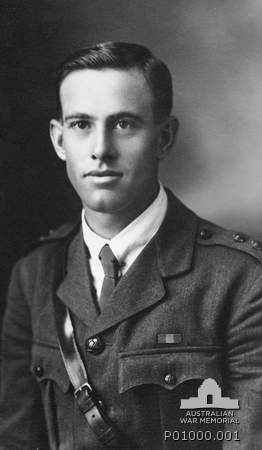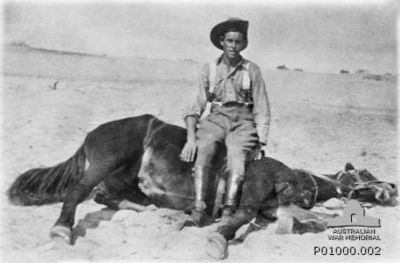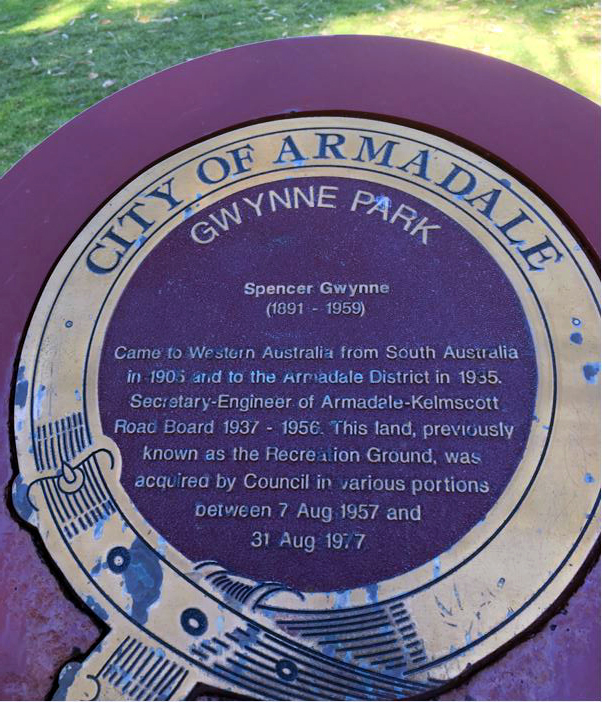Spencer Gwynne DCM MID
From Our Contribution
 AWM PO 1000.001 | |
 AWM PO 1000.02 | |
 | |
| Personal Information | |
|---|---|
| Date of Birth | 3 Sep 1891 |
| Place of Birth | Port Augusta, South Australia |
| Death | 24 Apr 1959, aged 67 |
| Place of Death | Armadale, Western Australia |
| Age at Enlistment | 23 years old |
| Description | 5'11" (1.80m) tall; weight 160 lbs (72.6 kg); fair complexion, brown eyes, brown hair |
| Occupation | farmer |
| Religion | Methodist |
| Address | NOK Jolimont, Western Australia |
| Next of Kin | Father Mr A Gwynne |
| Military Information | |
| Reg Number | 413 & W47851 |
| Date of Enlistment | 1 Oct 1914 |
| Rank | Lieutenant |
| Unit/Formation | 10th Light Horse Regiment / 3rd Light Horse Brigade, NZ and Australian Division |
| Date of Embarkation | 17 Feb 1915 - ? Mar 1915 |
| Ship Embarked On | HMAT A52 Surada |
| Date of Return | 23 Dec 1918 - 15 Jan 1919 |
| Ship Returned On | SS Leicestershire |
| Fate |
Wounded in Action 3 May 1918 at Es Salt Wounded in Action 29 Sep 1918 at Sasa near Damascus Returned to Australia |
| Medals |
Distinguished Conduct Medal Mentioned in Despatches 1914-15 Star British War Medal Victory Medal |
Contents
Pre War
Spencer's family moved to Woodanilling in Western Australia in 1905. Following school he worked in a legal firm for three years before working in the mines in the goldfields. Prior to WW1 he had returned to Woodanilling to take up a farm.
WW 1 Service
Enlisted in Katanning on 1 Oct 1914, aged 23, and completed his training with the main body of the 10th Light Horse Regiment as a member of 'C' Squadron, remaining with them in Egypt as a trooper. Leaving their horses behind them, on 15 May 1915 the Light Horse left Heliopolis bound for Alexandria where the next day they embarked on the SS Lutzow which carried them to Anzac Cove, where they remained on board for another day until the enemy ceased shelling the cove and boats in the area. Disembarked into two destroyers that carried them closer inshore, and they were ashore late on 21 May 1915.
On 7 Aug 1915 the 10th Light Horse supplied the troops for the 3rd and 4th attack waves at The Nek which was in front of Russell's Top where the 10th spent the entire month of August. The 10th Light Horse Regiment suffered casualties every day they held the front line trenches, and on 16 Aug 1915 at Russell's Top, Spencer was appointed Lance Corporal. Spencer spent 5 - 11 Oct 1915 in hospital with influenza before returning to the unit and remaining with them through to the evacuation to Lemnos Island, and then on 24 Dec 1915 the return to Alexandria in Egypt.
On 22 Jan 1916 at Heliopolis Base in Egypt Spencer was promoted Corporal. He was in hospital with septic sores from 3 - 9 Sep 1916, as they were preparing to move deeper into the Sinai desert. Promoted Temporary Sergeant on 11 Oct 1916 in the Sinai with the 10th Light Horse Regiment providing outposts for the main force. Promotion was confirmed on 12 Dec 1916, before he had another spell in hospital, this time with rheumatism which required him to be transferred on 9 Feb 1917 to the 14th Australian General Hospital in Abbassia, Egypt. While in hospital on 21 Mar 1917 he was advised that he had been awarded the Distinguished Conduct Medal (DCM) for his actions on 23 Dec 1916 at Magdhaba on the Sinai Peninsula, and had also been Mentioned in Despatches. It was 26 Apr 1917 before he finally rejoined his troop as they moved to Tel-el-Marakeb.
Spencer was sent to Port Said on 24 Sep 1917 to spend time in the rest camp until 4 Oct 1917. A period in the Imperial School of Instruction at Zeitoun followed from 13 Dec 1917 till 9 Mar 1918 when he graduated from Cadet School. He was Commissioned on 9 Mar 1918. Attached to the 4th Light Horse Regiment for a period, he was wounded with a bomb wound to his left ankle during a scrap on 3 May 1918 during the final throes of the Battle for Es Salt, west of Amman, in Palestine. Treated at the 43rd Stationary Hospital, he was away from his unit until 8 Jun 1918. On his return, on 10 Jun 1918 he was promoted Lieutenant. He then spent another 2 weeks at the imperial School of Instruction in August before returning to the 10th Light Horse in time to be wounded in action a second time on 2 Sep 1918, this time with a more serious Gunshot wound to his left wrist, fracturing the radius. This injury saw him receive treatment from the 4th Light Horse Brigade Field Ambulance, then the 31st General Hospital in Haifa, before embarking there on HMHS Assaye for Alexandria where he was sent to a Convalescent Hospital. Given the injury and the state of the war he was dispatched back to Australia where his Appointment was terminated on 11 April 1919 at 5th Military District having arrived on SS Leicestershire.
The Great Southern Herald on 31 July 1915, had a News report that mentioned Gwynne being from Woodanilling and being well while on Gallipoli.
"Mrs A Gwynne, 86 Jersey street Jolimont has received word that her son Sergeant Spencer Gwynne has been awarded the Distinguish Conduct Medal for gallantry and devotion to duty in the field."[1]
"2nd Lieutenant Spencer Gwynne, DCM, Doodlakine, wounded."[2]
"Wounded 2nd Lieut Spencer Gwynne DCM, Doodlakine, second occasion."[3]
Award Comment
DCM For conspicuous gallantry and devotion to duty.
"He gallantly went to the assistance of his troop officer, whose horse had been killed. He set a fine example to all ranks." [4] [5] The then Sergeant Gwynne was awarded the DCM for his part in the rescue of Lieutenant A.U. Martin, who had his horse shot from beneath him during the attack by the 10th Light Horse Regiment on Turkish forces at Magdhaba.
MID recommended 24 Dec 1916, awarded and promulgated[6] [7]
Post War
In 1920 in the Katanning district Spencer married Florence Mary Dival. He had called his farm 'Magdhaba'. A 1923 article in the press gave the results of the annual election of Woodanilling Road Board members, with Spencer one of two elected for the West Ward.[8] In 1925 Spencer was Chairman of the local Returned Soldiers Reunion.
"Mr Spencer Gwynne has been appointed secretary to the Woodanilling Roads Board in lieu of Mr H. Pittelkow, who resigned to take up work with the Main Roads Board."[9] [Spencer had resigned his position of Board member in order to do so having first been elected in 1923.] Spencer resigned this position in Sep 1932 in order to take up the position of Secretary to the Mingenew Road Board.
"Mingenew - At a meeting of the road board on August 31, Mr Spencer Gwynne was appointed secretary."[10]
An article in relation to the suicide of a Police Constable in Mingenew lists Spencer as identifying the body having known the deceased (a fellow member of the 10th Light Horse Regiment).[11]
" Mr Spencer Gwynne, who has for the last 4 and a half years occupied the position of secretary of the Mingenew Road Board, has received notice of appointment as secretary-engineer for the Armadale Road Board, and will leave to commence duty in his new position early next month. During the period of his residence at Mingenew the departing gentleman has interested himself very largely in local affairs, and has taken a leading part in bringing about many improvements in the district. As secretary of the Mingenew Hospital Association, he was chiefly instrumental in having the new hospital erected at Mingenew, and in this institution he will have the satisfaction of knowing that he will leave behind him a permanent memorial of his activities in the district. Mr. Gwynne has also evinced a lively interest in the sporting affairs of the district, having this year captained the local cricket team and also accompanied the North Midlands team to Perth for the Country Week Competitions in the capacity of manager. As a vice president of the Mingenew Parents and Citizens' Association, he has assisted in bringing about a number of reforms in educational facilities, and has generally displayed all those attributes that go towards the making of a highly estimable and desirable citizen. With Mrs. Gwynne, he has seldom been absent from a social function, and there is not the least doubt that the departure of Mr. Gwynne and his wife and family will leave a gap in the community. The good wishes of the people of Mingenew and district will undoubtedly go with them to their new home."[12]
The South West Advertiser 23 Aug 1940 reported the election of Spencer to be President of the Armadale RSL. [13]
WW 2 Service
On 12 Jan 1942 Spencer was called up for military duty, and appointed as a Lieutenant (Regimental number W47851) based at Perth VDC HQs. oversighting units first of all as part time Company Commander of the Armadale based 'D' Company of 2nd (Fremantle) VDC Battalion and later as a full time duty Adjutant of the Pinjarra Battalion Headquarters of the 4th (Bunbury) VDC Battalion, based at Pinjarra. His senior Non Commissioned Officer was the secretary of the Margaret River Road Board. On 26 Apr 1943 he was detached to the 1st (Perth) VDC Battalion , and on 3 May 1943 was transferred to that unit. In the meantime, on 18 May 1943 he was promoted Temporary Captain. On 1 oct 1943 he was Medical Boarded for (Anxiety Neurosis) and on 12 Oct 1943 he was moved to Western Command Recruit Reception & General Details Depot to facilitate his retirement which occurred on 10 Nov 1943
The South West Advertiser 22 Jan 1943 page 1 reported Spencer's promotion to Captain in the Army. [14]
Post WW 2
Spencer was a foundation member and President of the Armadale Trotting Club after being involved in the development of the recreation ground in West Armadale. In May 1946 Spencer gave the RSL notice that he was retiring from his position as Armadale President. However he remained with the Council until 1956, having built a new brick and tile home on Seventh Road. He was also a foundation member of the Armadale Rotary Club and the Armadale Bowling Club, also established on Gwynne park. Florence died 30 Dec 1998 in Thornlie aged 100.
Notes
The major recreation reserve in the City of Armadale is named Gwynne Park in his honour, and the name is also remembered with the Gwynne Park Primary School, and Gwynne Park Education Support Unit.
Roads Board Secretary for 28 years other than when he served during WW2. In 1988 Spencer's medals were presented to the Australian War Memorial in Canberra where they were displayed with a diorama of the Battle for Magdhaba.
Note: Gwynne Place in Roleystone is named after a different family.
References
- ↑ "PERSONAL.". The West Australian. XXXIII, (4,722). Western Australia. 22 May 1917. p. 4. Retrieved 31 August 2017 – via National Library of Australia.
- ↑ "WESTERN AUSTRALIA.". The West Australian. XXXIV, (5,036). Western Australia. 27 May 1918. p. 5. Retrieved 31 August 2017 – via National Library of Australia.
- ↑ "AUSTRALIANS IN ACTION". Kalgoorlie Miner. 24, (6194). Western Australia. 22 November 1918. p. 3. Retrieved 31 August 2017 – via National Library of Australia.
- ↑ "Government Gazette Notices". Commonwealth Of Australia Gazette (133). Australia, Australia. 21 August 1917. p. 1785. Retrieved 31 August 2017 – via National Library of Australia.
- ↑ London Gazette 26 April 1917, page 3944, position 6.
- ↑ 'London Gazette', Supplement No 30169 of 6 Jul 1917, page 6773, position 59
- ↑ "Government Gazette Proclamations and Legislation". Commonwealth Of Australia Gazette (174). Australia, Australia. 11 October 1917. p. 2664. Retrieved 31 August 2017 – via National Library of Australia.
- ↑ "Woodanilling". Great Southern Herald. XXI, (2,007). Western Australia. 21 April 1923. p. 2. Retrieved 31 August 2017 – via National Library of Australia. .
- ↑ "Social and Personal.". Great Southern Herald. XXV, (2,659). Western Australia. 2 April 1927. p. 2. Retrieved 31 August 2017 – via National Library of Australia.
- ↑ "COUNTRY NEWS.". The West Australian. XLVIII, (9,421). Western Australia. 6 September 1932. p. 6. Retrieved 31 August 2017 – via National Library of Australia.
- ↑ "FOUND SHOT". Geraldton Guardian And Express. VI, (1,010). Western Australia. 24 February 1934. p. 4. Retrieved 31 August 2017 – via National Library of Australia.
- ↑ "LOCAL AND GENERAL". Geraldton Guardian And Express. IX, (1,470). Western Australia. 27 February 1937. p. 2. Retrieved 31 August 2017 – via National Library of Australia.
- ↑ "ARMADALE R.S.L.". South Western Advertiser. 31, (1556). Western Australia. 23 August 1940. p. 5. Retrieved 31 August 2017 – via National Library of Australia.
- ↑ "ARMADALE NEWS". South Western Advertiser. 39, (1980). Western Australia. 22 January 1943. p. 1. Retrieved 31 August 2017 – via National Library of Australia.